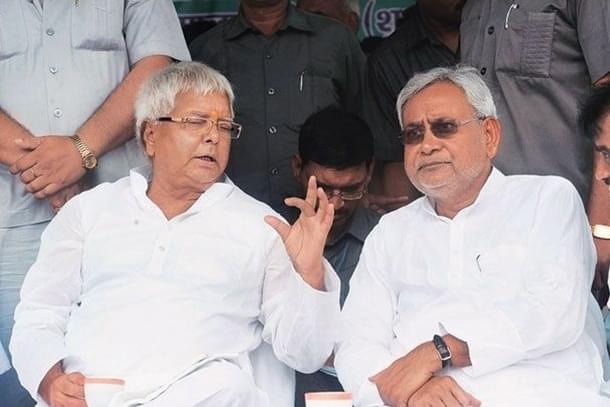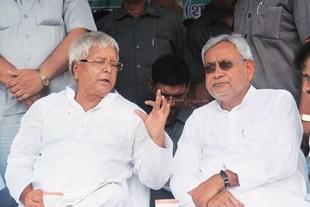Commentary
Why Findings Of Bihar’s Caste Survey Puts Both Lalu And Nitish In The Dock
Jaideep Mazumdar
Nov 08, 2023, 06:07 PM | Updated 06:05 PM IST
Save & read from anywhere!
Bookmark stories for easy access on any device or the Swarajya app.


The findings of the socio-economic survey of various caste groups in Bihar were tabled in the Bihar Assembly on Tuesday (7 November).
Chief Minister Nitish Kumar gloated over the successful conduct of the survey and urged the Narendra Modi government to replicate a similar exercise across the nation.
But he, and Rashtriya Janata Dal (RJD) supremo Lalu Yadav, should actually have been ashamed of the findings of the survey.
That’s because the survey reveals the condition of an overwhelming majority of the population of Bihar that has been ruled almost continuously for the last 34 years by Lalu Yadav (and his wife) and Nitish Kumar.
The findings of the survey are shocking: 34 per cent of the 2.76 crore households make do with a combined daily income of Rs 200 or less a day. Analysts say that many of these families have two or more working members, which means that each earns less than Rs 100 a day!
Bihar’s households, it must be mentioned here, are typically large and have five or more members. A household has, on an average, 5.5 members.
That means more than a third of Bihar’s population survives on Rs 36 or even less a day.
A majority of the state’s workforce are engaged in low-paying jobs of daily labourers. The survey categorised 67 per cent of the state’s population as housewives and students.
Of the remaining 33 per cent, 1.57 per cent (20 lakh) hold government jobs and a smaller percentage — 1.22 per cent, or 15.9 lakh — are employed in the organised private sector.
A little over 2 per cent of the state’s population (27.9 lakh) is employed in the unorganised private sector, while 7.7 per cenr (1.07 crore) are farmers and farm labourers and 16.78 per cent (2.18 crore) work as unskilled labourers across various sectors. Only 3.05 per cent of the population (39 lakh) are self-employed.
This compares poorly with the national average. The Periodic Labour Force Survey (PLFS) for 2022-2023 revealed that 22.7 per cent of the workforce across 21 major states of the country are engaged in organised sector jobs, compared to Bihar’s pathetic figure of 1.22 per cent.
Unorganised sector jobs are low paying and unskilled labourers earn even less a day. Most of the self-employed are also desperately poor and barely make a subsistence living through micro enterprises.
The survey revealed only 36.76 per cent families live in two-room or bigger houses while 26.54 per cent live in tin-roofed houses and 14.09 per cent in huts.
Most of the remaining 22.61 per cent do not have a roof over their heads or live in makeshift shacks.
A miniscule 4.38 per cent of the state’s population own vehicles. But an overwhelming majority of them own only two-wheelers while a miniscule 0.44 per cent own four-wheelers. But not all four-wheelers are private cars — a large number of them are buses, trucks and other commercial vehicles.
The extremely low internet penetration in Bihar — only 0.22 per cent of the state’s population have access to the internet for more than eight hours — is yet another indication of the backwardness of Bihar.
Bihar’s education system is in mess, as is evident from the figures that the survey has thrown up. Only 6.47 per cent of the state’s population are graduates and 22.67 per cent have studied only up to the primary level (classes 1 to 5).
The survey revealed that 14.33 per cent have studied up to the secondary level and 14.71 per cent have finished high school. All these figures are way below the national average.
What this means is that Lalu Yadav, who ruled Bihar (directly, and indirectly through his wife Rabri Devi) for 15 years and Nitish Kumar for the remaining 19 years (discounting the short spells of President’s Rule) have failed to improve the socio-economic plight of the people of Bihar.
What emerges from the survey is despite all the claims of the RJD and the JD(U), Bihar continues to remain in poverty.
Most children drop out of school because of poverty, poor or non-existent infrastructure and poor quality of education.
The Lalu Yadav-Nitish Kumar duo have failed to ensure good education, create job opportunities and improve the socio-economic condition of the people of the state despite having presided over Bihar’s destiny for 34 years.
But what is perhaps far more significant is that social justice has eluded Bihar. Lalu Yadav and Nitish Kumar, though ardent votaries of social justice and torchbearers of the Mandal (reservations) movement, have failed to improve the plight of Dalits, other backward classes (OBCs) and extremely backward castes (EBCs).
The socio-economic survey revealed that backward communities continue to lag behind general category groups in all parameters — employment in the formal sector, education, housing and economic status.
While only 25 per cent of general category households are very poor (monthly income of Rs 6,000 or less), the figure is 42.9 per cent for Dalits, 42.7 per cent for tribals, 33.6 per cent for EBCs and 33.2 per cent for OBCs.
Of households whose family incomes range between Rs 20,000 and Rs 50,000: 16.9 per cent belong to the general category, 8 per cent are tribals, 5.9 per cent are Dalits, 8.3 per cent belong to the EBC category and 10.7 per cent to the OBC category.
In the jobs sector: 58.5 per cent EBCs hold unskilled jobs as compared to 34.6 per cent people in the general category holding such jobs. The figure (holding unskilled and periodic jobs) for Dalits is 64 per cent, for tribals is 53.2 per cent and for OBCs is 42.8 per cent.
What is more, Lalu Yadav and Nitish Kumar have failed even their own communities. More than 35.8 per cent of Yadavs are very poor (household or family incomes below Rs 6,000 a month) while nearly 30 per cent Kurmis (Kumar’s caste group) have barely enough to make ends meet.
Among tribals, a majority of the largest groups — 52.09 per cent of the Santhals, 57.1 per cent of the Mundas, 52.32 per cent of the Mahlis and 59.68 per cent of the Cheros — are extremely poor.
The 34 years of rule of Bihar by Mandal parties has thus failed to yield any noticeable gains for the very communities in whose name Lalu Yadav and Nitish Kumar have enjoyed power. The Dalits, tribals, OBCs and EBCs continue to remain poor and backward in Bihar.
The much-touted survey, thus, lays bare the tragic failure of Lalu Yadav and Nitish Kumar to improve the plight of the people of Bihar, especially its backward communities.





